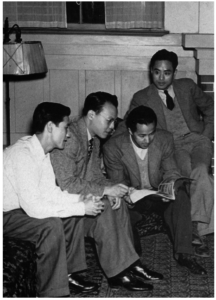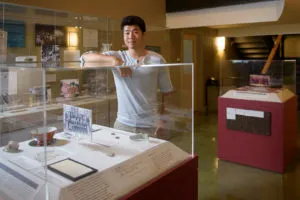June 30, 2014, a couple months before New Student Orientation. I needed to register for my language placement tests, yet when I opened the registration site, the language that I speak as fluently as English wasn’t listed.
I grew up speaking Cantonese as my first language, a language indigenous to southeastern China and Hong Kong, from which my parents immigrated. In fact, part of the reason why I chose to attend Stanford was that I got a brochure from the language department during Admit Weekend, listing Cantonese as one of its offered languages. I was excited to attend a university that would formally recognize my language and my culture as important enough to be taught.
Confused, I emailed the language department to ask whether there had been a mistake. My heart sank when I received their response: “Cantonese conversation courses do not fulfill the language requirement. If you have any experience with Mandarin, please take the Chinese placement test.”
Mandarin and Cantonese are as similar as Portuguese and Spanish. The spoken word is different; the characters vary depending on whether they are written in the simplified form of Mainland China or traditional form of Hong Kong and Taiwan. Linguistically, they are two separate languages. Cantonese is incomprehensible to a Mandarin speaker, and vice versa.
In short, the advertisements were false; my bilingualism did not meet the one-year language requirement. Cantonese classes are important enough to be taught, but not important enough to be recognized for the language requirement.
Why doesn’t Cantonese count for the foreign language requirement?
The real reason definitely doesn’t have to do with the number of Cantonese speakers in the world. There are an estimated 80 million Cantonese speakers across the world. In the U.S. alone, according to the U.S. Census, 458,840 people speak Cantonese and 487,250 speak Mandarin — a very close margin. In fact, there are more people that speak Cantonese in the U.S. than most of the other offerings in the language department that count toward the language requirement, such as Hawaiian (26,205) and even Japanese (449,475). Even Latin — a “dead” language — fulfills the language requirement, but not Cantonese.
It also doesn’t have to do with political legitimacy. Cantonese is an official language of Hong Kong and Macau, but not China. Yet Tibet is not its own country either — and Tibetan is recognized for the foreign language requirement.
Other peer institutions recognize and offer multiple Cantonese language classes beyond the conversational classes at Stanford. BYU, NYU, University of British Columbia, and University of Toronto provide one year of introductory Cantonese. Even at the high school level, San Francisco Unified School District, where over 75% of all the Chinese-American children identify as Cantonese speakers, has offered Cantonese bilingual programs for years—and they have a placement test.
Most confusingly of all, Stanford has a mechanism for earning a “Proficiency in Foreign Language Notation” through an Oral Proficiency Interview and Writing Proficiency Test. The tests are scored on the Foreign Service Institute/American Council on the Teaching of Foreign Languages scale. And guess what? Those tests are offered in Cantonese.
The very same language testing system the Stanford Language Center uses for proficiency evaluation recognizes Cantonese as a foreign language and provides mechanisms for placement testing. I could shell out $209 and take the exact same test that Stanford uses to assess proficiency in a foreign language — the problem clearly isn’t that placement tests are nonexistent.
In addition, after writing this article, the Stanford Language Center offered to proctor the Stanford Chinese placement test for me, customized for Cantonese. I would encourage students who speak languages without placement tests to contact the Language Center on an individual basis to see if an alternative placement test can be conducted. However, Stanford continues to lack an official Cantonese class that meets the language requirement.
So why is Cantonese excluded?
The Stanford Language Center
To find out more about how the Stanford Language Center decides which languages fulfill the requirement and which do not, I spoke with Elizabeth Bernhardt, director of the SLC and professor in German Studies.
According to Bernhardt, “All foreign languages meet the language requirement, with some caveats. Students must demonstrate proficiency in reading, listening, speaking and writing, which is usually fulfilled with a one-year sequence in the language. There is no prohibition against any language.” The reason Cantonese classes currently do not meet the language requirement, according to Bernhardt, is that the current conversational courses are not offered in a 12-15 unit sequence.
However, Stanford has offered a 12-15 unit Cantonese sequence in the past. According to Professor Sik Lee Dennig, who taught Cantonese at Stanford in 1997 and from 2001 to the current day, conversational Cantonese courses have been offered since 1997. In fall 2006, a one-year 15-unit Cantonese sequence, “First-year Comprehensive Cantonese,” was introduced for the first, and only, time after a group of students petitioned for its creation.
When I asked Bernhardt about why the Cantonese sequence ended after 2007, she cited a lack of student interest. “The problem is that students need to be proactive about their needs and rally interest in their communities,” the same way the original group of students in 2006 was able to raise support for a Cantonese class.
There needs to be “at least 10 students to request a full sequence in a language,” she said, for a class offering to be financially feasible. The funding in 2006-2007 came from the Vice Provost, which was a one-time grant that was not renewed after the cohort of students finished the sequence. Without additional funding, the only way to offer a 15-unit sequence in Cantonese would be to cancel an existing conversational or film class, which Bernhardt fears would reduce Cantonese enrollment even more.
Bernhardt’s concerns about a lack of student interest and finite budget are understandable. However, if the option to request classes or take a placement test in languages not taught at Stanford is inaccessible, how would students know to do so? If other students, like me, emailed the SLC Student Services Officer and received the same terse, “Cantonese does not meet the language requirement,” I wonder how many of them would be able to find out that they could request a language on their own.
Moreover, the current low enrollment in Cantonese could very well stem from the fact that conversational Cantonese does not count toward the language requirement. Stanford students may not have the academic space to take additional units of conversational Cantonese on top of their one-year language course. I imagine that if Cantonese offered a first-year sequence like Mandarin Chinese, more students would enroll.
Not to mention the high barriers to getting a Cantonese language sequence started as a student — Bernhardt’s student interest rationale is incongruous with the enrollment numbers in Special Language Programs, which have always been eligible for the language requirement. According to Explore Courses for the 2016-2017 school year, there was one student enrolled in first-year Bengali, two students enrolled in first-year Ukrainian, and five students in first-year Tagalog. Clearly, there are very few students enrolled in most of the Special Language Programs, yet these courses are still offered for the language requirement.
When I asked Bernhardt to clarify her 10-student criterion for successful petitioning for a language course, she replied, “Ten students who say they are passionately interested in taking a class generally translates into three students when everything is arranged and one or two by the end of the sequence.” Yet for Ukrainian, Tagalog, and other small language classes, there is no activation energy required, no initial ten students. They are offered year after year.
It seems that there is an undue burden placed on students who want Cantonese to be taught and recognized — a burden not placed on any other language. The problem with the status quo is that for Cantonese, and Cantonese only, SLC’s expectation is that students must fight for the class to exist, while most languages are continuously, not contingently, available without any student action.
Stanford’s Cantonese roots

Stanford’s refusal to recognize Cantonese classes for the language requirement ignores the integral role that Cantonese and Cantonese speakers have played in the university’s very conception.
Leland Stanford amassed his massive fortune (which funded Stanford’s founding) largely through the construction of the Central Pacific Railroad, which had recruited and imported thousands of Chinese laborers to work on the railroad. Most of these laborers came from southern China and spoke Cantonese.
Records show that these early Chinese Americans were often given the most dangerous jobs, such as detonating explosives for train tunnel construction. Additionally, they were often discriminated against and underpaid for their work. The Chinese Railroad Workers in North America Project has documented the histories of these early Chinese.
Beyond the unnamed Chinese railroad workers who added to Leland Stanford’s wealth, many of these railroad workers transitioned to positions in the early days of Stanford’s founding as butlers, employees, janitors and chefs.
I spoke with Bright Zhou ’16 M.S. ’17, who curated the exhibit, “Chinese American at Stanford: A Reflexive Archaeology,” that remains on display at the Archaeology Center through May 15. Some of the pieces in Zhou’s exhibit come from the excavation of the Arboretum Chinese Quarters, one of the housing sites for Chinese workers right on campus.
“Most of the payroll records of Chinese railroad workers have names that start with Ah, like Ah Ming, which is a linguistic choice found in Cantonese speakers,” said Zhou. “Jane Stanford’s butler and confidant, Ah Wing, also followed this linguistic pattern,” indicating that he too was likely Cantonese-speaking.
Although Leland Stanford himself publicly lobbied against Chinese immigration, the railroad workers and blue-collar workers he employed for his own enterprises speak to the contributions of Chinese (and particularly Cantonese-speaking) people to his legacy.
Cantonese today

Stanford’s lack of a Cantonese course that fulfills the language requirement is even more baffling given the impact of Cantonese-speaking Chinese-Americans on the Bay Area. Walk into San Francisco’s Chinatown and chances are somebody is speaking Cantonese. Chinatowns, especially those created before the latter half of the 20th century, were populated by the initial exodus of Chinese immigrants from southern China.
Currently, however, Cantonese is declining in popularity. Many parents in the U.S. teach their children Mandarin exclusively, knowing that many institutions like Stanford do not recognize Cantonese. Chinese schools across America, including bilingual schools and extracurricular classes, have stopped offering Cantonese classes due to declining enrollment. The weekend school I grew up attending, Wisdom Chinese School, announced that they would stop offering Cantonese classes after nearly 20 years because the small enrollment was not enough to justify the cost of hiring teachers. It wasn’t until outraged parents joined forces to both petition the school and fundraise money to hire a teacher that the school finally relented and tentatively continued Cantonese classes.
Yet most experts are optimistic about the future of Cantonese. I spoke with Professor Sik Lee Dennig, the only Cantonese instructor at Stanford, about the role of Cantonese in modern society. “Cantonese is often called a living fossil,” Dennig explained. “As a hybrid of the ancient Chinese language and the indigenous languages in southern China, Cantonese has preserved many of the characteristics of these ancient languages. A notable example is the set of final stop consonants in Cantonese (–p, -t, and –k), which features prominently in rhymes in classical Chinese poetry.” Mandarin has lost these endings.
Dennig is a strong believer in inherent cultural value, and when I asked her about a popular view that Cantonese will be pushed out by Mandarin, she said, “I don’t feel Cantonese is dying.” Dennig pointed to protests in Guangzhou in 2010 to preserve Cantonese TV stations and creative approaches in teaching Shanghainese, another regional language, in after-school programs.
Still, Dennig thinks that the future of Cantonese and other regional languages will depend on a mix of factors, including “the Chinese government’s stance on languages,” which currently allows for regional languages to be spoken at home but requires Mandarin Chinese to be taught and used officially; migration patterns and “grassroots efforts to preserve regional languages.”
Personally, I felt the absence of Cantonese greatest in my freshman year at Stanford. Chinese culture is very diverse, and although I grew up with tons of friends who spoke Cantonese at home and had a similar cultural background to mine, I came to Stanford to find myself incredibly alone. Even in the Hong Kong Students Association, which I tentatively joined, very few students actually spoke Cantonese.
I made my first Cantonese-speaking friend at Stanford in the dining halls — an ironic continuation of the contributions of early Chinese dining hall workers at Stanford.
Karen Wong has been working at Stern Dining Hall since 2015. She says hi to every student who swipes in, and when she helped a boy in front of me in line practice his Mandarin, I said hi to her in Mandarin (one of the few words I know). When she asked me if I was fluent, I admitted that I didn’t know Mandarin at all and that I spoke Cantonese. She was thrilled, telling me that Cantonese was her first language too.
From then on, I always chatted to her about life and school in Cantonese whenever I stopped by the dining halls. Hearing the tones of a language I grew up with soothed some of the homesickness I carried. For Chinese New Year, she gave me a red envelope, a holiday tradition, and I nearly cried because I hadn’t expected anyone to celebrate with me that year.
Unfortunately, Karen has been laid off by Stanford Dining and will end her time at Stanford this spring. It’s a personal blow for me but also devastating for the community of students who look forward to her friendly greeting at every meal. It’s also another reminder of how fragile Cantonese existence is at Stanford.
Stanford’s refusal to allow Cantonese classes to meet the foreign language requirement goes beyond unfair academic policies. It represents a larger problem of diminishing Asian-American classes and majors at Stanford. As Bright Zhou pointed out, “Look at the number of Asian-American classes and how many Asian-American majors there are.” A previous Daily article described the vicious cycle of decreasing enrollment in Asian-American Studies classes due to lack of visibility, resulting in fewer course offerings and even less enrollment. Allowing Cantonese classes to count toward the language requirement would encourage more students to learn Cantonese and greater visibility of the Cantonese-speaking community that has always existed at Stanford.
My language matters. My culture matters. My presence matters. And if you believe that, then Cantonese classes should receive the same legitimacy as all of our languages.
Contact Samantha Wong at slwong ‘at’ stanford.edu.
